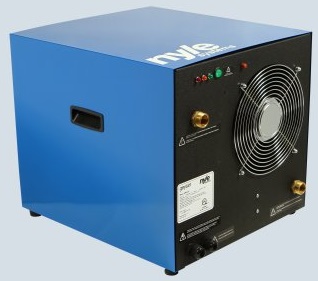Heat Pump Water Heater
Nyle Geyser separate heat pump

http://water.nyle.com/r-series/
http://water.nyle.com/wp-content/uploads/2015/10/GEYSER-2015-RESIDENTIAL-ORDER-FORM-New-page-001.jpg
This can be added to an existing conventional resistance water heater. That means you don't have to buy it up front to get hot water in the house. It also can be positioned in the optimal place in the house to draw its hot air. Also if the tank fails then you just need to replace the tank (and vice-versa if the heat pump fails). It uses two water connections and a connection to the tank’s thermostat.
It makes water at about 120 degrees F.
Cost is about about $1000 with shipping.
Would be good if it is possible to find a low cost large resistance heated tank (I currently cannot find one).
Could use two 50 gal tanks
https://www.lowes.com/pd/Whirlpool-50-Gallon-240-Volt-6-Year-Regular-Electric-Water-Heater/1000000444 $389 (minus 5%, plus tax) $350 (minus 5%, plus tax) each when buy two
Using two tanks allows incremental buy, avoids someone using all the hot water, provides two heating elements on at the same time, and provides redundancy from failure. One serves one set of bathrooms and the other serves another set. Provide 3 way shutoff valve mechanism for switching all bathrooms to one heater in case of failure. Use one Geyser heat pump to feed both water heaters.
I divide hot water distribution into two zones so that someone using massive amounts of hot water in one bathroom (family bathroom) does not deprive another bathroom (my bathroom). Connect the Geyser to tank one. The hot water from tank one feeds zone 1 (family bathrooms) and also feeds into the 'cold' inlet on tank 2. Zone 2 (my bathroom) is fed from the hot outlet on tank 2. Geyser have approved this configuration.
Tanks that incorporate a heat pump
AO Smith 80 Gallon Voltex
80 Gallon Voltex Residential Hybrid Electric Heat Pump Water Heater SKU:HHPT-80
A.O. Smith makes the Voltex in two sizes (60 gallon and 80 gallon). The larger unit costs about $1,850 to $2,100; its EF is 2.33 and its first-hour rating is 84 gallons.
Whirlpool 80-Gallon
10-Year Hybrid Water Heater
http://www.lowes.com/pd_89263-135-HPE2K80HD045V_1z0zp1j__?productId=3370964&pl=1 $1,767.96 (minus 5%, plus sales tax)
Reliance 80 Gal
Hybrid Heat Pump Water Heater (10-80-DHPST)
http://www.acehardware.com/product/index.jsp?productId=67659356&cp=2568443.2568452.2631246.2864136 $1800 plus tax
Stiebel Eltron Accelera 300
It has an 80-gallon tank and costs about $2,400. Its EF is 2.51 and its first-hour rating is 78 gallons.
http://www.stiebel-eltron-usa.com/products/accelera-heat-pump-water-heaters
Other possibilities
Could use it with a Marathon 105 gallon resistance water heater (but way too expensive)
Rheem Marathon Heavy Duty MHD105238
https://www.gpconservation.com/marathon-mhd105238.html $1,385
http://www.polk-burnett.org/content/marathon-water-heater
Useful info
http://www.greenbuildingadvisor.com/blogs/dept/musings/heat-pump-water-heaters-come-age
http://energy.gov/energysaver/heat-pump-water-heaters
My heat pump water heater will be located next to a wood burning fire in the mud room and thus will have a good source of heat to draw from and so will operate very efficiently.
Higher gallon heat pump tank is more efficient than a small heat pump tank. Do not buy a small heat tank unit. Get 80 gallons or ideally higher.
Needs plenty of air space around it eg 1000cuft.
Electric-resistance elements in a typical water heater can heat 20 gallons per hour, a heat pump can typically only manage about 8 gallons per hour. That's why heat pump water heaters also have a resistance heater coil.
They also dehumidify and cool the room in which they are installed.
Typical Energy Factor for a heat pump water heater ranges from 2.0 to 2.5, while a typical EF for an electric-resistance water heater is 0.9.
They make quite a lot of noise (louder than a refrigerator).
An interesting idea is putting a heat pump water heater in the conditioned attic given that heat rises up the house into the attic. In a perfect world you would have a heat pump in the attic to move the heat back to the lower floors.



